How to travel responsibly to the Galapagos Islands
Tourism is an activity that affects the places where it is developed and is our duty as travelers to be as responsible as possible with the ecosystem.
The Galapagos ecosystem is one of the most fascinating places to be due to the unique experiences that it can offer. From fascinating encounters with wildlife and marine life, observing unique birds that can’t be found anywhere else in the world, the only marine iguanas breathing out salt while resting on a rock, the only penguin that inhabits in the northern part of the equator just swimming next to you. The Galapagos transforms experiences that may look impossible at the beginning into daily experiences during your tour.
And that is why the Galapagos should be protected, not only by the government, NGO’s, private companies and tour operators. It should be protected by the people who travel there in order to preserve this natural paradise.
Now, what can you do to travel more responsibly?
Pick a way to visit the Islands
The original way of visiting the Galapagos islands is on board a naturalist cruise. Cruises are strongly regulated by the Galapagos National Park, the number of vessels in the islands is limited and their itineraries are designed to have small groups on visitor sites during the day and avoid over crowded trails.
If you pick a naturalist cruise:
 Once you picked how you will spend your time in the Galapagos here are some other recommendations:
Always keep your distance
As the Galapagos wildlife is not afraid of the human presence, this tends to become into a tempting opportunity for travelers to touch them in order to get some pictures. And as harmless as it may seem to pat them or get too close to cute seal pups, tortoises and other animals this may harm them in many ways:
Once you picked how you will spend your time in the Galapagos here are some other recommendations:
Always keep your distance
As the Galapagos wildlife is not afraid of the human presence, this tends to become into a tempting opportunity for travelers to touch them in order to get some pictures. And as harmless as it may seem to pat them or get too close to cute seal pups, tortoises and other animals this may harm them in many ways:
 Don’t feed the animals
Don’t feed the animals
 Avoid wasting
Avoid wasting
 Be careful while shopping
Be careful while shopping
 Remember that your visit to Galapagos plays an important role for the ecosystem and the local businesses. Enjoy this natural paradise and create unforgettable moments here and remember that supporting responsible tourism is the best way to protect the Galapagos Islands.
A small action can create big changes on the long run.
Carlos Beate is the Commercial Manager at Andando Tours. Andando Tours offers exclusive traveling experiences, specializing in sailing around the Galapagos Islands and overland along the magnificent Avenue of Volcanoes on the Ecuadorian Andes.
If you would like to be a guest blogger on A Luxury Travel Blog in order to raise your profile, please contact us.
Remember that your visit to Galapagos plays an important role for the ecosystem and the local businesses. Enjoy this natural paradise and create unforgettable moments here and remember that supporting responsible tourism is the best way to protect the Galapagos Islands.
A small action can create big changes on the long run.
Carlos Beate is the Commercial Manager at Andando Tours. Andando Tours offers exclusive traveling experiences, specializing in sailing around the Galapagos Islands and overland along the magnificent Avenue of Volcanoes on the Ecuadorian Andes.
If you would like to be a guest blogger on A Luxury Travel Blog in order to raise your profile, please contact us.
- Keep in mind that smaller cruises fit up to 16 passengers on board: a smaller group means less impact. You will reduce the impact on land and will increase the quality time you spend with your guide and learn about the issues that the Galapagos is facing and your guide will be able to ensure that everyone follows the trails or get too close to the Galapagos wildlife.
- Additionally, cruises use ocean friendly products on board and some of them offer refillable water bottles during your trip.
- Although this tours are not strictly regulated yet, try to check on companies that work with local operators that work hard to lessen the environmental impact of their operation.
- The groups can start from 12 to 25 people on board the tour.
- Make sure that the hotel where you will stay has a proper management of all types of waste, uses friendly biodegradable products and avoids the use of single use plastic.
- Avoid activities like fishing or water sports.
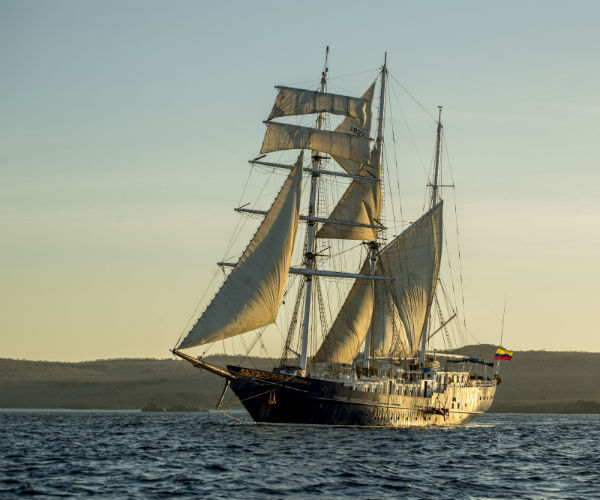 Once you picked how you will spend your time in the Galapagos here are some other recommendations:
Always keep your distance
As the Galapagos wildlife is not afraid of the human presence, this tends to become into a tempting opportunity for travelers to touch them in order to get some pictures. And as harmless as it may seem to pat them or get too close to cute seal pups, tortoises and other animals this may harm them in many ways:
Once you picked how you will spend your time in the Galapagos here are some other recommendations:
Always keep your distance
As the Galapagos wildlife is not afraid of the human presence, this tends to become into a tempting opportunity for travelers to touch them in order to get some pictures. And as harmless as it may seem to pat them or get too close to cute seal pups, tortoises and other animals this may harm them in many ways:
- Humans carry germs and diseases that the animals can’t defend themselves from
- Humans carry a foreign smell (no offense here) but it can harm populations of different species. For example: If you touch a seal pup, your smell will transfer to it and its mother will not be able to recognize and neglect him which means that the seal pup will have to live on its own (a nearly impossible task for that species at a young age).
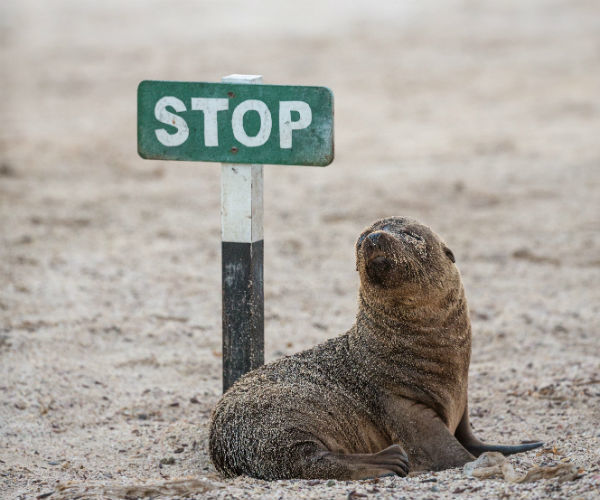 Don’t feed the animals
Don’t feed the animals
- If you bring along food during your visit to the beach, always keep it in your backpack as some curious finches will take advantage of the opportunity and take some bites out of it.
- No matter what, don’t feed tortoises or any other wildlife
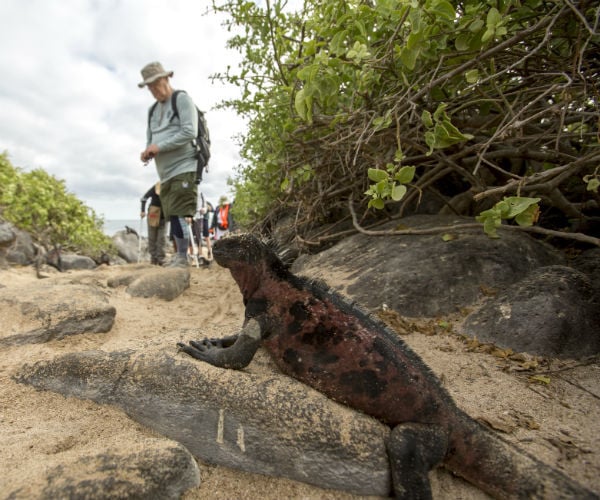 Avoid wasting
Avoid wasting
- Get your own refillable bottle of water to avoid buying plastic bottles.
- Use the necessary amounts of water and don’t litter the beaches or parks.
- Use a waterproof reusable dry bag.
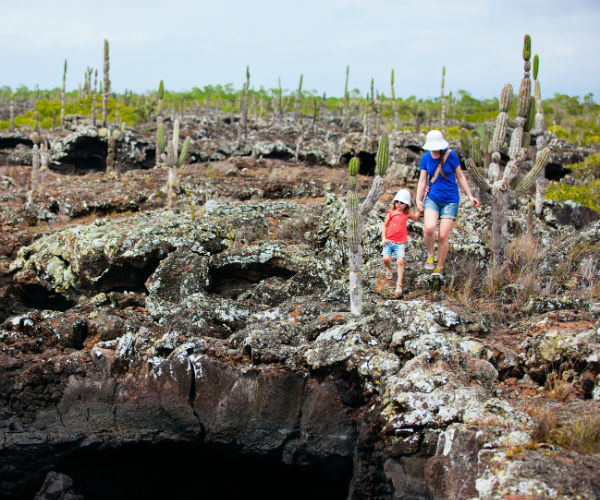 Be careful while shopping
Be careful while shopping
- Don’t buy souvenirs made from coral, rocks, tortoise shells. This encourages a faster destruction of the environment.
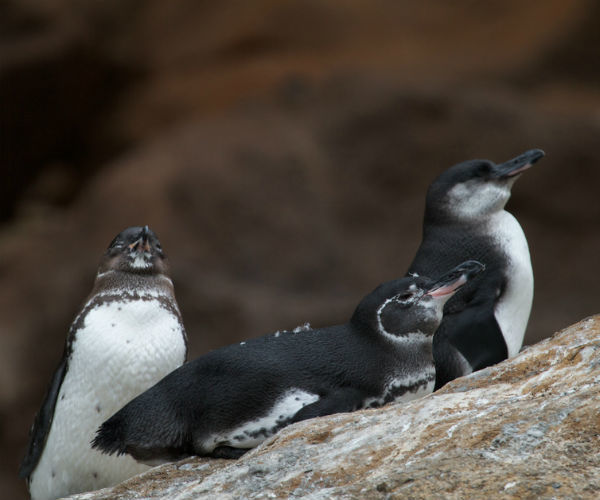 Remember that your visit to Galapagos plays an important role for the ecosystem and the local businesses. Enjoy this natural paradise and create unforgettable moments here and remember that supporting responsible tourism is the best way to protect the Galapagos Islands.
A small action can create big changes on the long run.
Carlos Beate is the Commercial Manager at Andando Tours. Andando Tours offers exclusive traveling experiences, specializing in sailing around the Galapagos Islands and overland along the magnificent Avenue of Volcanoes on the Ecuadorian Andes.
If you would like to be a guest blogger on A Luxury Travel Blog in order to raise your profile, please contact us.
Remember that your visit to Galapagos plays an important role for the ecosystem and the local businesses. Enjoy this natural paradise and create unforgettable moments here and remember that supporting responsible tourism is the best way to protect the Galapagos Islands.
A small action can create big changes on the long run.
Carlos Beate is the Commercial Manager at Andando Tours. Andando Tours offers exclusive traveling experiences, specializing in sailing around the Galapagos Islands and overland along the magnificent Avenue of Volcanoes on the Ecuadorian Andes.
If you would like to be a guest blogger on A Luxury Travel Blog in order to raise your profile, please contact us.Did you enjoy this article?
Receive similar content direct to your inbox.


I hope that people read this very sensible and sensitive post. As we travel, and certainly not just to the Galápagos Islands, we ought to bear all of this advice in mind.
Dear Maggie,
I hope this reach as many people as possible so everyone can travel responsibly not only to the Galapagos Islands but to other amazing places with delicate ecosystems too.
Quite rightly there are many references to the Galápagos ecosystem through this excellent piece. Perhaps what required stating more explicitly is that once we, as humans, travel to observe that environment we become a part of that ecosystem and we influence it.
The point about introducing germs into that ecosystem is highly indicative of the unwitting damage that we can inflict, thereby distorting an ecosystem that has existed for millennia.
The advice to keeping your distance and minimising your impact on these ecosystems must be observed if these ecosystems are to survive.
Dear Gerald,
Thanks for this deep insight from the article!
Maybe the picture of the sail boat is the inspiration for our future. It’s certainly zero emissions. Little noise to scare the wildlife. Wood and sails are recyclable. All very sustainable. I’d love to sail around the Galápagos #spirit of Charles Darwin.
Just as Charles Darwin did on the world famous HMS Beagle. That will be ideal!
I think we need to be careful when shopping FULL STOP. Whether buying souvenirs in the Galapagos or shopping at our local store we need to think a lot more about firstly whether we actually need the goods. Though I often think that buying souvenirs is providing work and income for local people. Then secondly we need to consider the origins of the goods. Is their production sustainable?
Dear Claire,
Souvenirs like t-shirts, hats and anything that looks mass produced it is not manufactured in the Galapagos Islands. Most of the things that you consume in the Galapagos come from Ecuador’s mainland. And buying those things do help the Galapagos economy as you help a business in Galapagos.
What we don’t recommend is to buy souvenirs that are made with corals, tortoise shells, teeth from animals, sand, volcanic rocks, etc as that will mean that they will start taking more and more resources from the islands.
This article made me think about all the other souvenirs I’ve bought from travels I’ve done in the past. Most especially those from islands and beaches where normally souvenirs are made from shells or corals or sand. Luckily, most of the time I buy shirts or wooden/metal magnets.
Dear Amanda,
Thanks for your comment! -I hope that this blog creates a change on how we travel!
With more impetus on being environmentally friendly, I think increasingly travellers are also aware of how they holiday and the credentials of where they stay, as well as what they do when they get there. I think it’s so important to protect tourist destinations because all too often they can be spoilt by tourism. It’s the air, land, sea and animals that need to be cared for and it’s good to know there are lots of ways we can be more conscious about travelling responsibly. There are also lots of things we, or at least I, don’t necessarily consider or take into account, like with animals being vulnerable to human germs and diseases. Fantastic advice that I hope those looking to travel to the Galapagos will read and take on board.
Dear Kirsty,
Thanks for your insight.
Sometimes as travelers we are not completely aware of many things as every environment is different. The important part is to learn as much as possible on how to become a better traveler :)